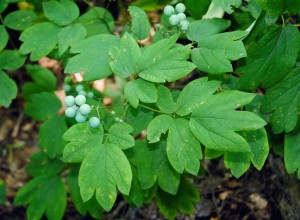Caulophyllum (Blue cohosh) is a small genus of perennial herbs in the family Berberidaceae. It is native to eastern Asia and eastern North America.
Contents
Uses
These poisonous plants has been used for many things throughout history, the three similar species generally have similar properties and uses. This plant is occasionally used in woodland gardens as an ornamental. Children should not be allowed to eat the attractive blue fruits, as these plants contain chemicals that are known to cause cell damage. The powdered roots have been shown to cause dermatitis and irritation of the mucous membranes.
Historically the root of Caulophyllum has been used as a medicine for: cancer, internal parasites, smooth muscle function, spasms, diuretic, menstruation, and childbirth. It is best known for the latter two uses. Various Native American tribes are also recorded as having used this plant for similar medicinal purposes. While no current widely marketed medicines are based on this plant, modern herbalists and practitioners of alternative medicine still utilize this plant as a natural therapy. Research on the medicinal potentials of this plant are ongoing.
Benefits
First, it is an effective remedy for rheumatic pains that affect the smaller joints of the hands and feet with sudden, excruciating cramping pain as well as aching wrists. The pain experienced by such patients is of traveling nature and moves from one part of the body to another swiftly. Second, caulophyllum is prescribed to hasten the process of childbirth, ease the pain and problems associated with labor and also to alleviate problems endured after childbirth. This medication is effective when a pregnant woman experiences feeble and erratic labor pain or may have intensely aching, but ineffective contractions of the uterine muscles. In addition, caulophyllum is also recommended for women who may be experiencing fake labor pains.
The homeopathic medication caulophyllum may help to prevent routine miscarriages and, at the same time, alleviate the acute hurting following childbirth and provide relief from menstrual soreness. Since caulophyllum is a stimulant for the uterine muscles, it is helpful in inducing menstruation flows in women who have been suffering from lack of menstrual flow. This homeopathic remedy is also beneficial for those suffering from stomach complaints that usually lead to spasmodic dyspepsia (impaired digestion). Some patients who may suffer from stomach pain accompanied by spasms would benefit if they try caulophyllum.
In addition, as a homeopathic remedy caulophyllum is also effective for treating other health problems related to women, for instance amenorrhea (absence of menstrual periods), menstrual abnormalities and/ or dysmenorrhea (painful menstruation). This medication is also effective in facilitating labor when the opening of the uterus is exceptionally rigid. Homeopathic practitioners recommend the use of caulophyllum for people suffering from rheumatic pains which are transient in nature, moving from one part of the body to another very quickly. All these apart, caulophyllum is also useful in curing ailments encountered during pregnancy, such as parturition (the process of brining up an infant) as well as lactation (formation and secretion of breast milk). It is also effective in treating leucorrhoea (white or yellowish mucus discharge from the vagina suggesting an infection) in young girls, which is usually pungent and excoriating.
Cautions
Blue cohosh is LIKELY UNSAFE for adults when taken by mouth. It can cause diarrhea, stomach cramps, chest pain, increased blood pressure, increased blood sugar, and other severe side effects.
Special Precautions & Warnings:
Pregnancy and breast-feeding: It is LIKELY UNSAFE to take blue cohosh by mouth during pregnancy. Some of the chemicals in blue cohosh can cause birth defects. When taken by the mother late in pregnancy, blue cohosh can cause severe heart problems in the newborn baby, and can also be toxic to the mother.
Many midwives still use blue cohosh to make childbirth easier, because blue cohosh causes the uterus to contract. But this is a dangerous practice, and it should be avoided.
Heart conditions: There is some concern that blue cohosh might make certain heart conditions such as chest pain (angina) and high blood pressure worse. There is evidence that blue cohosh can cause blood vessels in the heart to become smaller and decrease oxygen flow to the heart. It might also increase blood pressure. Don’t use blue cohosh if you have a heart condition.
Diabetes: There is some concern that blue cohosh might make diabetes worse. It can raise blood sugar levels in some people who have diabetes.
Diarrhea: Blue cohosh might make diarrhea symptoms worse.
Hormone-sensitive conditions such as breast cancer, uterine cancer, ovarian cancer, endometriosis, or uterine fibroids: Blue cohosh might act like estrogen. If you have any condition that might be made worse by exposure to estrogen, don’t use blue cohosh.
Interactions
- Medications for diabetes (Antidiabetes drugs) interacts with BLUE COHOSH
Blue cohosh might increase blood sugar. Diabetes medications are used to lower blood sugar. By increasing blood sugar, blue cohosh might decrease the effectiveness of diabetes medications. Monitor your blood sugar closely. The dose of your diabetes medication might need to be changed.
Some medications used for diabetes include glimepiride (Amaryl), glyburide (DiaBeta, Glynase PresTab, Micronase), insulin, pioglitazone (Actos), rosiglitazone (Avandia), chlorpropamide (Diabinese), glipizide (Glucotrol), tolbutamide (Orinase), and others. - Medications for high blood pressure (Antihypertensive drugs) interacts with BLUE COHOSH
Blue cohosh seems to increase blood pressure. By increasing blood pressure blue cohosh might decrease the effectiveness of medications for high blood pressure.
Some medications for high blood pressure include captopril (Capoten), enalapril (Vasotec), losartan (Cozaar), valsartan (Diovan), diltiazem (Cardizem), amlodipine (Norvasc), hydrochlorothiazide (HydroDiuril), furosemide (Lasix), and many others. - Nicotine interacts with BLUE COHOSH
Blue cohosh contains chemicals that work similarly to nicotine. Taking blue cohosh with nicotine might increase the effects and side effects of nicotine
Other names
Actée à Grappes Bleu, Blue Ginseng, Caulophylle, Caulophylle Faux-Pigamon, Caulophyllum thalictroides, Cohosh Azul, Cohosh Bleu, Graines à Chapelet, Léontice Faux-Pigamon, Papoose Root, Cohosh Azul, Squaw Root, Yellow Ginseng
References
Source: Wikipedia, https://en.wikipedia.org/wiki/Caulophyllum
Herbs2000, http://www.herbs2000.com/homeopathy/caulophyllum.htm
WebMD, http://www.webmd.com/vitamins-supplements/ingredientmono-987-BLUE%20COHOSH.aspx?activeIngredientId=987&activeIngredientName=BLUE%20COHOSH

